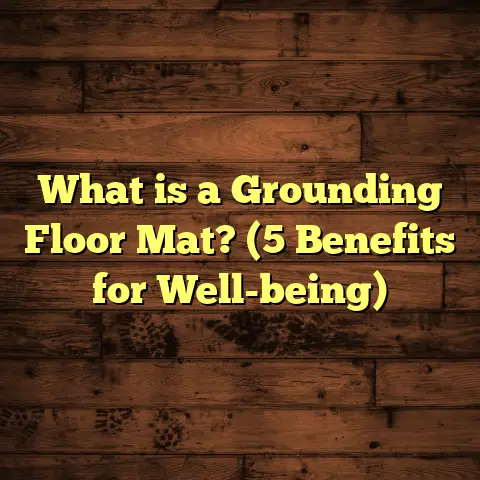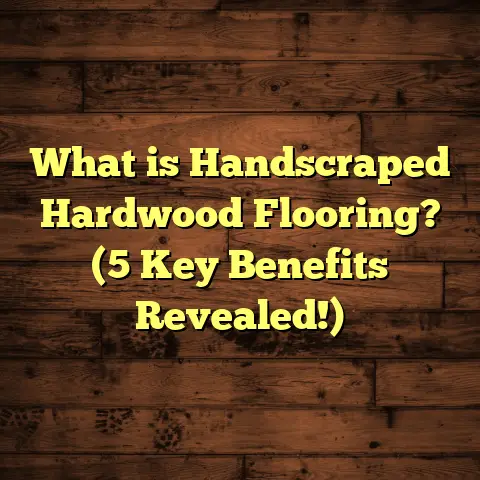What is Deck Flooring? (5 Benefits for Outdoor Spaces)
Sometimes, the best place to relax ends up being outside your door. But here’s the funny thing: outdoor spaces often don’t feel nearly as comfortable or inviting as the inside of your house. Why? Because most outdoor surfaces are either too rough, slippery, or just plain boring. That’s exactly where deck flooring shows its worth. It can turn a bland, unusable patch in your yard into a cozy, stylish retreat where you want to spend time. Over the years, I’ve worked on all sorts of deck flooring projects, and I’ve learned a lot about what makes a good deck—and what doesn’t.
What Is Deck Flooring?
So, what is deck flooring really? At its core, deck flooring is the surface material that covers the floor of a deck. If you think about a deck as a raised platform connected to your home or sitting somewhere in the yard, then deck flooring is the actual layer you walk on. Unlike indoor floors, which mainly focus on looks and comfort, deck floors have to stand up to sun, rain, snow, temperature swings, foot traffic, and sometimes heavy furniture or grills.
Deck floors can be made from various materials. The most common are different kinds of wood—like pressure-treated lumber, cedar, redwood, or tropical hardwoods such as ipe. These woods have their own strengths and weaknesses when it comes to durability and maintenance. Then there’s composite decking, which mixes recycled wood fibers with plastic. This gives you something that looks like wood but lasts longer and needs less maintenance.
When I first installed a cedar deck about 12 years ago for a client who loved that natural wood smell and look, I quickly understood how much attention deck materials need. Cedar is beautiful and insect resistant but also requires regular sealing to keep that rich color from fading into grey. That project taught me that picking the right material depends a lot on where you live and how much time you want to spend maintaining your deck.
Deck flooring isn’t just about laying down boards; the installation process is critical. You have to build a solid frame underneath, space the boards correctly for water drainage, and use the right fasteners so everything stays sturdy and looks clean. Trying to rush this step or cut corners can lead to problems like boards warping, squeaking, or even rotting.
Why Deck Flooring Matters So Much
You might be wondering why people get so invested in decking. After all, couldn’t you just have a simple concrete patio or stone slabs? Sure, but decking offers something unique in terms of comfort, style, and usability.
Outdoor spaces can be tough environments for any floor because they’re exposed to all kinds of elements—sun that fades colors and weakens materials; rain that promotes rot and mold; cold that causes expansion and contraction; dirt and debris that make surfaces slippery or messy.
A well-designed deck flooring system tackles those challenges head-on by choosing materials and construction methods designed specifically for outdoors. This means you get a floor that feels good underfoot, looks great year-round, lasts long without costly repairs, and creates an outdoor living room you actually want to use.
From my experience, once homeowners have a sturdy, attractive deck floor beneath their feet, they end up using their outdoor spaces way more than they thought they would. It becomes their go-to spot for morning coffee, weekend barbecues, or just hanging out with family.
Five Benefits of Deck Flooring for Outdoor Spaces
Let me walk you through five big reasons why deck flooring makes such a difference.
1. Built to Last Through Weather
One of the biggest challenges for any outdoor floor is weather. Deck flooring materials need to stand up to moisture from rain and snow without rotting or swelling. They also have to resist damage from UV rays which can bleach colors and weaken fibers.
Here are some data points I’ve picked up over time:
- Pressure-treated wood decks generally last about 15-20 years if maintained properly.
- Composite decks can last 25 years or more since they don’t rot or splinter.
- Tropical hardwoods like ipe often survive 40+ years but cost more upfront.
- Cedar and redwood last 10-15 years typically but need regular sealing to slow decay.
In coastal areas with salty air, I always recommend composite or tropical hardwoods because salt can speed up rot in softer woods.
When I was working on a beach house deck last summer, we used ipe because it holds up so well against salt air and heavy foot traffic from vacationers. The homeowners appreciated not having to worry about replacing boards every few years.
2. Minimal Maintenance
If you’re like most people I meet, spending hours each year sanding and sealing your deck sounds exhausting. That’s why many homeowners opt for composites or tropical hardwoods—they require way less upkeep.
Composite decks generally only need washing with soap and water once or twice per year. No sanding or staining required.
I did a job for a young family who had two energetic kids and two dogs. They wanted a safe surface that wouldn’t splinter and could withstand muddy paws. Composite decking was perfect because it stayed looking fresh with just quick hose-downs after rainstorms.
Wood decks require more care: cleaning annually and sealing every couple of years keeps moisture out and color vibrant. But if you’re willing to put in that effort, natural wood’s beauty is hard to beat.
3. Design Flexibility
Deck flooring comes in so many colors, textures, and widths that it’s easy to find something that matches your home’s style perfectly. Some composites mimic natural wood grains so closely you’d have trouble telling them apart without touching.
I remember one client who chose a deep walnut-colored composite with wide planks for a sleek modern vibe contrasting against their light siding. It instantly made their backyard look contemporary and inviting.
Besides colors and textures, decks can be installed in various patterns—straight boards, diagonal layouts, herringbone patterns—to add visual interest.
This kind of design freedom means your deck can be more than just functional; it can be a true extension of your home’s personality.
4. Safety Underfoot
Outdoor floors need to be safe when wet or icy. Many decking materials come with textured surfaces or anti-slip finishes designed to prevent slips even after rain or watering plants.
Raised decks also require careful installation to avoid gaps or loose boards that could trip people up.
When installing decks for families with kids or older adults, I always recommend materials with good grip and regular inspections for any loose screws or warping boards.
This attention to safety helps avoid accidents in outdoor areas that often see lots of activity.
5. Increases Home Value
Adding a deck or upgrading an old one is one of the best ways to boost your home’s resale value. According to data from the National Association of Realtors:
- Homeowners recover about 70% of their deck installation costs when selling.
- Homes with decks tend to sell faster than comparable homes without outdoor living spaces.
- A well-designed deck adds curb appeal that attracts buyers immediately.
I’ve helped several clients whose decks became major selling points during open houses—buyers loved having ready-made outdoor entertaining areas.
How I Handle Deck Flooring Installation
When I get called in for deck flooring projects, I go through a consistent process that helps ensure quality results:
Assessing Site Conditions
First step: I check where the deck will go and how it relates to the house. Is it fully exposed to sun? Does rain drain well? Are there trees dropping leaves constantly? Understanding these factors helps me decide what material suits best.
Choosing Materials
Next comes selecting the right decking material based on budget, aesthetic preferences, climate concerns, and maintenance willingness.
For example:
- For budget-conscious clients in mild climates: pressure-treated wood
- For low-maintenance seekers: composite decking
- For luxury builds in harsh weather: tropical hardwoods
Planning the Frame
A strong frame is the backbone of any deck floor. I use pressure-treated lumber for joists spaced every 16 inches to support weight evenly.
Installing Decking Boards
Board spacing is key—usually about 1/8 inch gap—to allow water drainage and prevent trapping moisture underneath.
Fasteners matter too. Stainless steel screws resist rust better than galvanized nails. Hidden fastener systems create clean looks without visible screws.
Quality Checks
Before finishing up, I inspect every inch for squeaks or loose boards and fix them immediately.
Keeping Your Deck Looking Great
Taking care of your deck flooring can extend its life by years:
- Clean regularly with mild soap solutions.
- Check fasteners annually.
- Seal wood decks every 2-3 years.
- Trim nearby bushes or trees to improve airflow.
- Avoid dragging heavy furniture across boards.
- Remove snow gently using plastic shovels on wood decks (metal can scratch).
I remember once helping a client whose neglected cedar deck had turned gray and started splintering badly within three years simply because no one sealed it properly after installation. After resealing and thorough cleaning, it looked almost new again.
Case Study: Transforming an Old Patio into a Deck Oasis
A couple in my neighborhood wanted an inviting backyard space but had an uneven concrete slab covered with cracked tiles. We decided to build a raised composite deck over a new frame.
The project took about two weeks from demolition through framing and board installation.
They selected medium-brown composite planks with hidden fasteners for sleek lines.
The result? A warm gathering spot perfect for grilling dinners or relaxing with friends.
Their feedback? They use it daily now—from morning coffee to evening bonfires—and love how easily it cleans after rain compared to their old patio.
Budgeting Your Deck Project
Cost is often the biggest question when planning decking because prices vary widely depending on materials:
| Material | Cost per sq ft (installed) |
|---|---|
| Pressure-treated wood | $15 – $25 |
| Cedar / Redwood | $25 – $35 |
| Composite decking | $30 – $45 |
| Tropical hardwoods | $40+ |
Labor costs depend on region and project complexity but expect around $7-$15 per square foot.
I rely on tools like FloorTally to estimate costs accurately by inputting local material prices, labor rates, waste factors (typically 5-10%), and project dimensions. This helps me avoid surprises when ordering materials or quoting clients.
Unique Insights From My Experience
Over time I’ve noticed some patterns not often discussed:
- Boards closer to the ground or shaded areas tend to degrade faster due to moisture buildup.
- Using joist tape under boards in wet climates can extend lifespan by preventing rot.
- Hidden fasteners not only improve looks but reduce trip hazards caused by raised screw heads.
- Choosing wider boards (5-6 inches) creates fewer seams that collect dirt.
- Light-colored composites hold up better against heat absorption on sunny decks.
- Frequent washing prevents mold growth better than waiting for visible stains.
- Investing extra in quality fasteners pays off by reducing maintenance calls later.
Questions You Might Have
Q: Can I install deck flooring myself?
A: If you’re handy with tools and willing to follow instructions carefully, yes! But framing requires precision; mistakes can cause structural issues later. For complex designs or large decks, professional help is a good idea.
Q: How long does installation usually take?
A: Small decks (100-200 sq ft) take about 3-5 days; larger ones (300+ sq ft) can take 1-2 weeks depending on site prep complexity.
Q: Which decking material holds value best?
A: Tropical hardwoods hold up extremely well but cost more initially. Composites offer great long-term value due to low maintenance while pressure-treated wood costs less upfront but needs more upkeep.
Q: How do I protect my deck from sun damage?
A: For wood decks: apply UV-resistant sealants every couple of years. Composites generally have built-in UV protection but still benefit from regular cleaning.
Wrapping Up My Thoughts on Deck Flooring
Deck flooring has been one of the most rewarding parts of my work because it turns unused outdoor spots into places people love spending time in. Getting it right means balancing aesthetics with durability and maintenance demands suited to your lifestyle.
If you’re thinking about adding or upgrading a deck floor yourself or hiring someone else: focus on choosing the right materials for your environment and budget; plan installation carefully; maintain regularly; and enjoy watching how your outdoor space becomes an everyday retreat.
Want advice tailored for your home’s conditions? Just ask—I’m happy to share what I’ve learned over thousands of square feet of decking projects!





